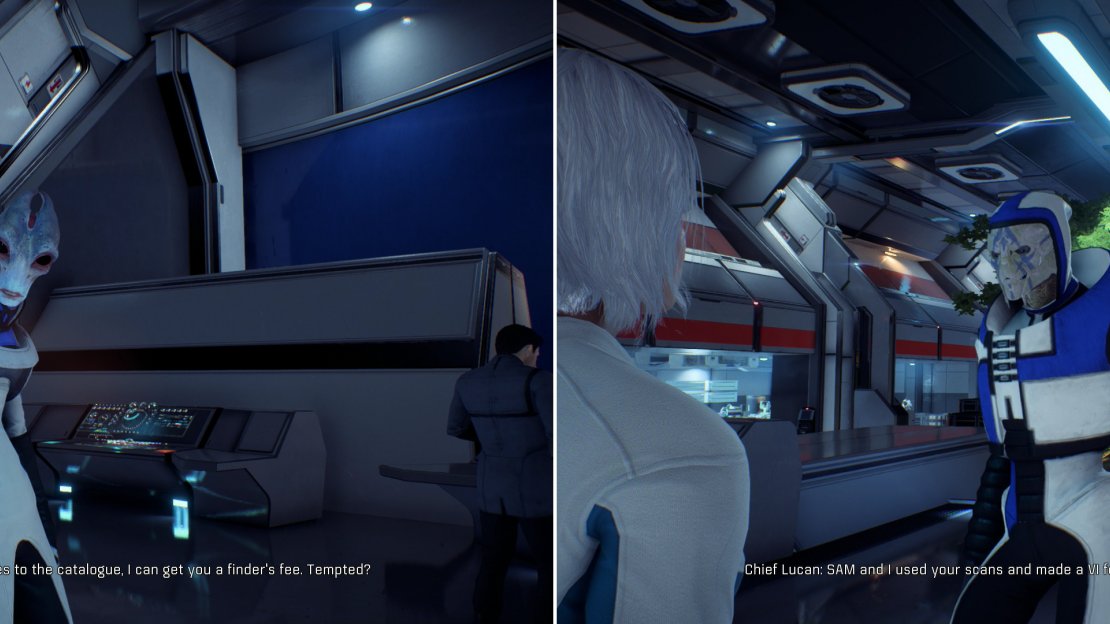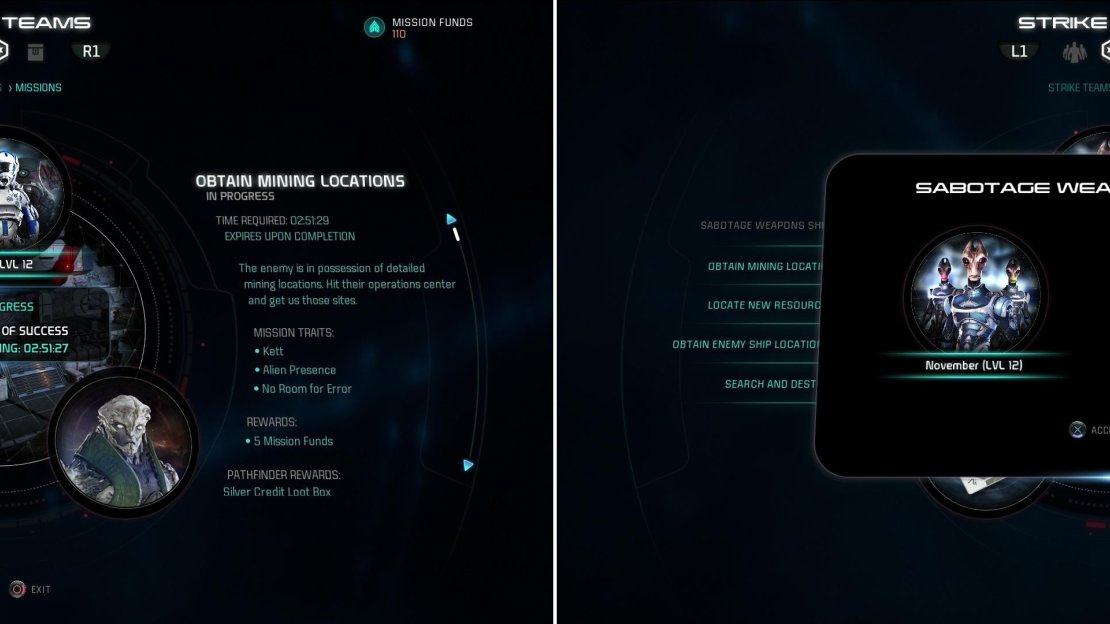Exploring Operations¶
There’s a lot to see and do on the Nexus, so let’s go explore, start some open-ended quests, and get some minor encounters out of the way before dealing with some of the more substantial diversions the Nexus has to offer. At the eastern end of the Operations level you’ll find several scientists, whom you talked to at the end of “Task - Getting to Know the Nexus”. You can now talk to them all again individually to get more quests from them, some of which will take you quite a while to complete.
Professsor Herik will ask you to scan wildlife (left) while Chief Lucan will ask you to scan minerals (right).
Chief Lucan (the Turian) will give you the quest “Task - Hitting Rocks For Science”. Professor Herik (Salarian) will bestow up on you the quest “Task - Comparatively Alien”. Doctor Aridana (Asari) has the most interesting job “Task - Missing Scientists”. It’s relatively simple, but it will require you to leave the Nexus, so put it in the back of your mind for now. Before you leave, be sure to use the nearby console to get the initial prep phase of the tasks “Task - Hitting Rocks For Science” and “Task - Comparatively Alien” out of the way, so you can start making proper progress on them as you explore.
After that, there are only two other things of immediate interest on this level, the first of which being the Arms Merchant, who runs a shop north of where Kandros waits. Note the sparse collection of expensive weapons he sells and don’t be shy about selling any Salvage items you may have picked up thus far (they serve no greater purpose). You’ll be able to farm credits soon enough, but for now, just ignore these weapons.
Different missions and strike teams have different traits, which work together to determine your odds of success (left). Successfully completing missions earn you rewards (right).
Strike Team Missions¶
Return to where Kandros lurks and interact with the circular Strike Team Missions console nearby. Kandros gave you an excuse for what these missions are and how they operate in the Andromeda lore, but none of that needs to concern you, what matters is that this is your gateway to both multiplayer and timed missions.
The substance of this mode are, of course, the missions, of which you’ll have a list to choose from. Missions are ranked into three grades, Bronze, Silver and Gold, which basically affects their difficulty, and of course the reward you get for successfully completing said missions. APEX missions are denoted with a stylized chevron symbol, and these missions you can choose to play through yourself in multiplayer, if you so choose. Each mission also have a number of “Mission Traits”, which are special modifiers that tie in to the traits (negative or positive) your Strike Teams possess. Old missions will expire and new missions will rotate in as time passes.
At its most basic, you simply assign Strike Teams to a mission, wait a set amount of time, then check back to see if they succeeded or failed. In the latter case your Strike Team may gain a negative trait (hindering their chance of success on missions with conflicting traits) and some consolation XP, while in the former case you’ll get some Reward Boxes, much more XP, Mission Funds (usually either five or ten) and perhaps a positive trait. Higher level Strike Teams are more likely to succeed at missions than lower level ones, all things being equal.
It get more complicated than that, of course, as your Strike Teams can affect mission outcomes considerably. Not only do they all have levels and traits (both positive and negative) which affect mission outcomes, but you can also equip them with various gear, which can be purchased in the Strike Team menu by expending Mission Funds. Once purchased, this equipment stays with a team for the rest of their career (until replaced by something superior, anyways) and always give a raw bonus to their “Effectiveness” (their chance to succeed at a mission, in general) or their Effectiveness in certain situations (based on the mission traits). This equipment tends to have a relatively high Mission Fund cost early on (not to mention requiring a Strike Team to reach certain levels), and since Mission Funds can also be spent to recruit new teams, it’s something you might want to save for later.
As for the rewards… well, this is what makes Strike Team Missions worth doing. Credits are easily the least interesting reward you’ll get, enough so that Credit Loot Boxes might as well be ignored, since they offer you pathetically little in the way of incentive. Material Loot Boxes are somewhat less of a waste, but since most Common and Uncommon resources (the fruits of Bronze and Silver Material Boxes) can be easily found or purchased (and there are easy enough ways of making money), they’re not all that noteworthy, either.
Research Data Loot Boxes, on the other hand, are fairly valuable, as it’ll allow you to be less frugal when researching upgrades, and even Bronze-tier missions can be expected to give you thirty points towards a random Research Data point type per box. Item Loot Boxes are where it’s really at, however, as they’ll reward you with weapons, almost all of which will be sound, immediate upgrades to your initial gear… and even unimpressive items can always be broken down for materials, which can, in turn, be used to create equipment you may have researched earlier.
Given the fact that Strike Team Missions take no in-game resources on your part, and the timer counts down whether you’re playing or not, you might as well always be attempting them as long as there’s a reasonable chance of success. At worst, it’s a way to passively boost your income, armaments and resources with minimal menu-based management on your part.


No Comments